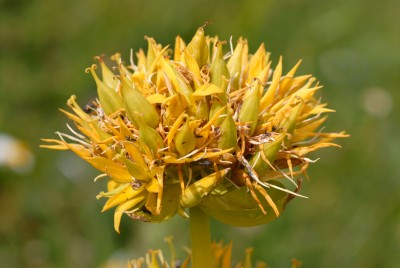Yellow Gentian – Gentiana lutea

Common Names: Yellow Gentian Root, Gentian, Gentiana lutea, Gentian root, Bitter Root, Radix Gentianae, European Gentian, Wild Gentian, True Gentian
Latin Name: Gentiana lutea
Origin: Europe
Short Introduction
Yellow Gentian propagates in two ways. In cultivation, Gentiana lutea is reproduced by dividing its roots. Naturally, this plant multiplies by seeds, which, upon ripening, are dispersed by wind thanks to their specialized adaptations. Seed dispersal occurs from August to late September. For home growing, seeds require several months of stratification, or can be sown in autumn. The plant prefers clay soils with ample moisture, shelter from wind, and indirect light. Young plants should be expected by the end of April the following year. Harvest the roots before flowering, as they contain the highest concentration of active compounds at this time.
Detailed Description
The root of Yellow Gentian, or Gentiana lutea, is renowned for stimulating the appetite, supporting blood formation, accelerating recovery, and assisting women with menstrual issues.
Botanical Information
Gentiana lutea is a robust herbaceous perennial, typically standing 50–115 cm tall, and is commonly found in alpine regions. It has an unbranched stem densely lined with striking oval leaves reminiscent of lily-of-the-valley. The green, veined, oval leaves can reach up to 30 cm in length. At the top of the stem rises a shaggy yellow flower that features both male and female organs, blooming in May and June. The seeds are light brown. The root of Yellow Gentian is typically 30 cm long and about as thick as a thumb, though it can grow up to twice this size. The usable root is yellow-brown in color.
Origin and Distribution
Yellow Gentian is not native to the Czech Republic but was introduced there in the 1920s and 1930s for liqueur production. It thrives in mountainous regions, so plantings were carried out in the Giant Mountains, Ore Mountains, Orlické Mountains, Šumava, and the Hrubý Jeseník. Its true homeland is southern Europe—particularly Alpine and sub-Alpine pastures. Interestingly, livestock avoids this plant, likely because of its distinctly bitter taste.
Usage / Dosage
The root of Yellow Gentian is primarily used for digestive and stomach problems. The root is valued in both medicine and veterinary practice—officially recognized as Radix Gentianae in pharmacopoeias. Using Yellow Gentian root alleviates dyspeptic symptoms related to disorders of the gall bladder, liver, and pancreas. Gentiana lutea also supports blood formation, benefits the central nervous system, and acts as a tonic during convalescence after serious illness. Its use improves digestion, and helps increase the production of urine, pancreatic enzymes, intestinal, and gastric juices. The root is also employed in cases of general weakness and is often mentioned as a strengthener for the human immune system. Yellow Gentian’s positive effects extend to women’s health, especially for menstrual discomforts.
Active Compounds
Gentiana lutea contains bitter glycosides, particularly gentiopicrin and amarogentin, which are responsible for its bitter taste. Other compounds include alkaloids (gentianine), terpenes, mucilage, pectin, and more.
Traditional Dosage
Make a decoction by simmering 1 teaspoon of root in 500 ml of water for 30 minutes. Due to its strong bitterness, honey can be added for taste. Excellent for making tinctures.
TIP:
Yellow Gentian Root Tincture – Gentiana lutea Tincture
2 parts Yellow Gentian root
1 part dried orange peel
½ part ground cardamom
Mix all together and steep in 1 liter of brandy.
- an outstanding stomach tonic
- effective for restoring appetite
- promotes digestion
Warning: Not suitable for individuals with high blood pressure, pregnant or breastfeeding women.
